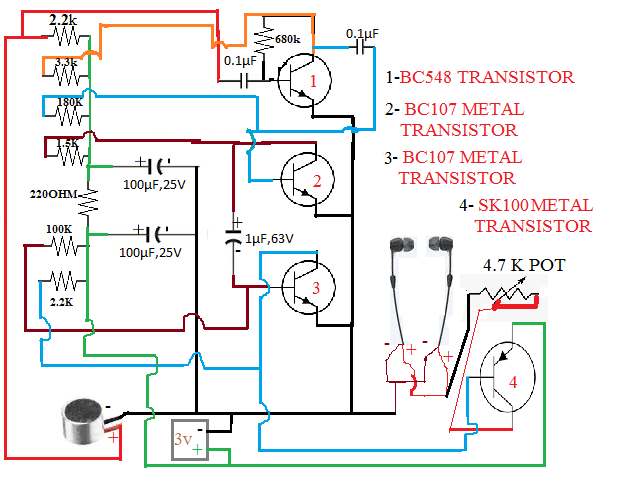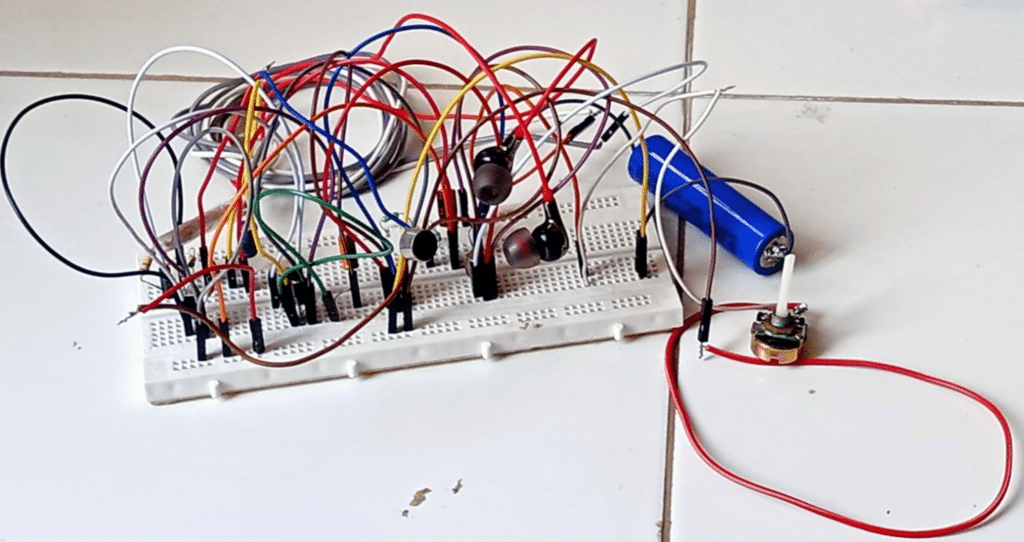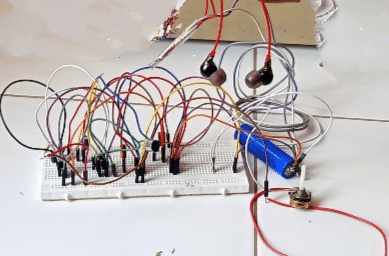
The hearing ability of any person can decrease with age; so he/she will face too many problems. Hearing aid is a solution that can makes the sound louder so he/she can hear, communicate more fully in every activity.
Hearing aid is a small size electronic device by which a person with hearing loss can hear as clear as a regular person.
There are three major section of a hearing aid:
- Microphone: – to convert audio signal into electrical signal
- Amplifier : – to strengthens the signals (using transistor)
- Receiver : – to convert electrical signal into sound waves .
we use earphone as receiver so as to convert electrical signal into sound waves and even it is easy to use it.
Working
The Electret Microphone(condenser mic)is used to convert sound signal into electrical signal.To amlify these electrical signal we use transistor’s as transistor is used for amplification. Here in our proposed hearing aid project we use combination of 3-npn(BC-548,BC-107,BC-107)& 1-pnp(sk-100)transistor as amplifier.
The output electrical signal from microphone is amplified by transistors BC-548 and this amplified signal is applied to the base of Metal transistor BC-107for further amplification. We use here a 1µF,63V coupling capacitor to pass this amplified signal to the base of another Metal transistor BC-107.
This amplified electrical signal is applied to a metal pnp transistor SK100 to drive Mobile earphone,which will convert the incoming amplified electrical signal into sound signal.we use mobile earphone as receiver,it is worn over and put into the ear during use.Here we also use a 4.7 k POT to minimise the pitch of sound to a minimum level during very louder sound which is inconvenient for the user.It is for user safety as during very louder sound like train horn on a railway station the user can move the wiper of 4.7k pot so that the sound will not annoying.
So in a brief of our proposed project ,first we convert the sound signal into electrical signal than boost it via different transistor combination and than again reconvert the boosted electrical signal into sound signal so that the earlier signal which was not audible by someone is now audible due to its high pitch.
Advantage
- 1.Our proposed Hearing aid can make communication easier for a person with hearing loss(basically age-related hearing loss).
- It can easily be assembled and easy to use as only we need to put earphone in ear and rest of the circuit in pocket after assembled on a small PCB.
| LIST OF COMPONENTS | ||
| NAME | QUANTITY | APPROX. COST |
| ELECTRET MICROPHONE (CONDENSER MIC) | 1 | 30/- |
| MOBILE EARPHONE LEAD | 1 | 100/- |
| BREADBOARD | 1 | 45/- |
| 3.7 VOLT CELL | 1 | 40/– |
| TRANSISTOR BC-548 | 1 | 10/- |
| TRANSISTOR BC-107 | 2 | 10*2=20/- |
| TRANSISTOR SK-100 | 1 | 20/- |
| LED | 1 | 2/- |
| 220OHM RESISTOR | 1 | 1/- |
| POT-4.7K | 1 | 15/- |
| CAPACITOR- 1µF,63V | 1 | 10/- |
| CAPACITOR- 100µF,25V | 2 | 10*2=20/- |
| CAPACITOR- 0.1µF(104) | 2 | 2*2=4/- |
| REGISTOR- 2.2 KΩ | 2 | 2*2=4/- |
| REGISTOR- 680 KΩ | 1 | 2/- |
| REGISTOR- 100 KΩ | 1 | 2/ |
| REGISTOR- 180 KΩ | 1 | 2/ |
| REGISTOR- 1.5 KΩ | 1 | 2/ |
| REGISTOR- 220 Ω | 1 | 2/ |
| REGISTOR- 3.3 KΩ | 1 | 2/ |
Table 1: List of components use in project (Bill of Material)



RAKESH JAIN received a Master’s degree in VLSI, B.E. in electronics and communication, and DIPLOMA in electronics. He is currently working as an Assistant professor in ECE department at Geetanjali Institute of technical studies, Udaipur. His research area is SENSOR and Microcontrollers. He has 26 copyright and 3 Indian patents. He has also been honored with Mewar Scientist Award2023.







SIR,
WHAT ABT NOISE CANCELLATION?
Sir,
Thank you very much for the very useful and affordable cost project. Sounds good.
Schematic Diagram shows 3V battery while test setup and bill of materials mentions 3.7V
What is the minimum and maximum power supply input range?